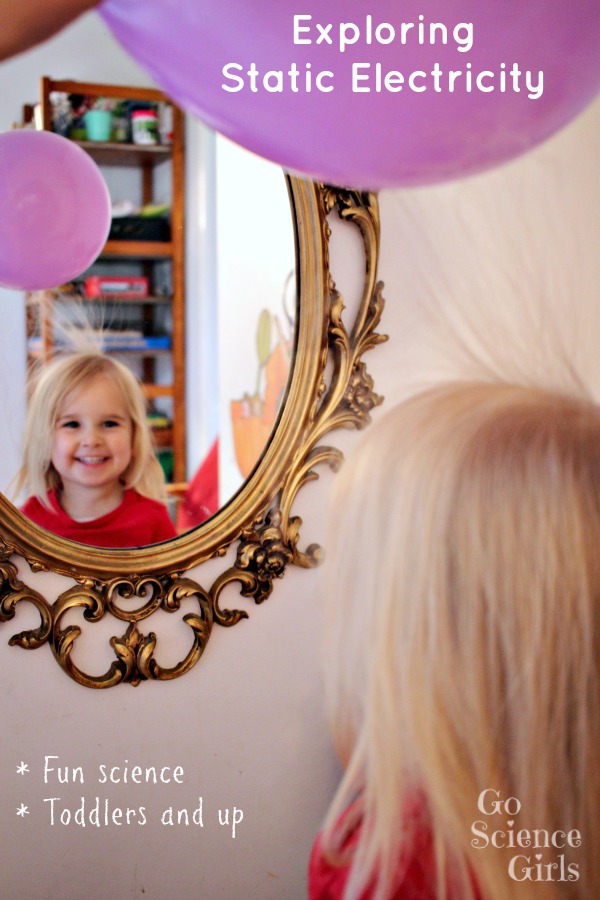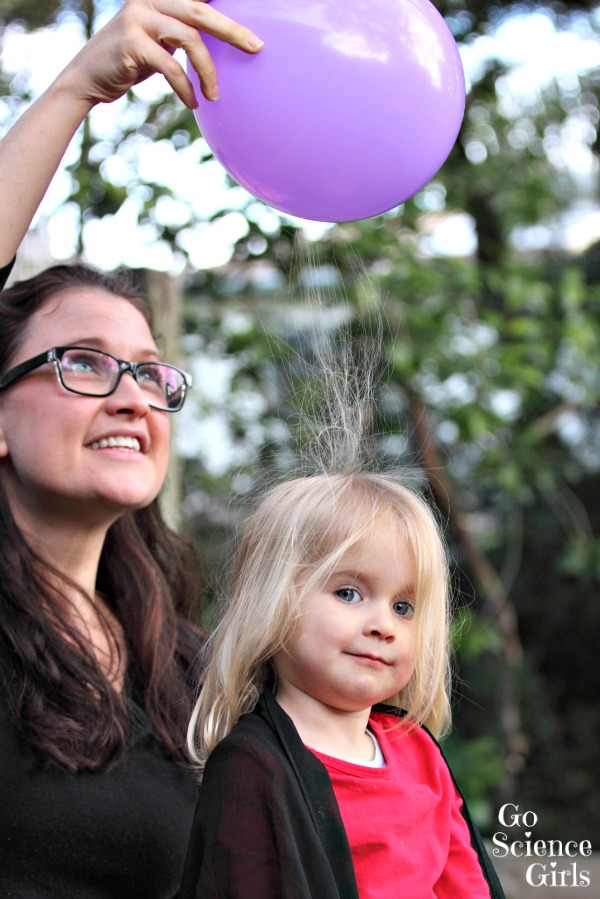Static Hair! A simple static electricity science experiment for toddlers.

Have you ever noticed how static electricity can sometimes make your hair stand on end? This happens all the time on our trampoline and the kids think it’s awesome. (These shots were from a few years ago. Look how tiny Bumble and Jewel were!)

Bumble and I thought we would play around and see if we could recreate this static hair effect another way.
Suitable for…
I’m adding this to our list of activities for 1-2 year olds. Bumble was 2 years, 10 months old when we took most of these shots, but you could try this with much younger kids too. It’s a great science experiment for short toddler attention spans!
To make static hair, you will need:
- Hair
- Blown up balloon
- Low mirror (optional)
Super fine hair that’s just been brushed works best.
What to do
Rub a balloon on your child’s head. Take the balloon away, and the hair strands should start to stand on end! Or if you keep the balloon close enough, some hair strands should ‘reach out’ to touch the balloon. Fun!
 If your toddler is a Miss Independent like Bumble is, then they might like to give this a go themselves. It’s tricky with those tiny toddler-sized arms!
If your toddler is a Miss Independent like Bumble is, then they might like to give this a go themselves. It’s tricky with those tiny toddler-sized arms!

Fun Science: What is happening here?
Let’s start at the beginning. All things are made of atoms. Inside atoms are protons, electrons and neutrons. Protons are positively charged, and electrons are negatively charged. Usually atoms have the same number of protons and electrons, cancelling each other out. But sometimes atoms can ‘lose’ or ‘gain’ an electron, resulting in a positive or negative charge. Things that have opposite charges (positive and negative) will attract. Things that have like charges (positive and positive, or negative and negative) will repel.
OK, now let’s get to the fun bit. When a balloon rubs against hair, some of the electrons from the hair ‘jump’ onto the balloon. This makes the balloon negatively charged (because it has ‘gained’ some electrons) and the hair positively charged (because it has ‘lost’ electrons). This causes two things to happen simultaneously. Firstly, the individual hair strands repel each other, as they are the same charge. This makes the hair strands stand up straight, separated from each other. The second thing that happens, is that the positively charged hair strands are attracted to the negatively charged balloon, making it look like the hair strands are ‘reaching out’ for the balloon.
I haven’t gone into any atomic level science explanations with Bumble just yet, lol. For now, we’ve just been saying things like “I wonder what will happen? Look your hair is standing up! This is caused by static electricity. When you rub the balloon on your hair, it causes static electricity, and that is what makes your hair stand up, and reach for the balloon like that. Static electricity is all part of science. Isn’t science awesome?”
We also tried this experiment outside, with Mr Banya taking the photos. Bumble loves running over to see her picture on the back of the camera. It’s not quite the same level of interaction as when we’re in front of the mirror, but it’s the next best thing. (And it means I can be in the shot too! A rare thing these days…)

Please note…
All kids’ activities on this blog require attentive adult supervision. Burst balloons can represent a choking hazard. Parents and carers will need to judge whether a particular activity is appropriate their child’s age and skill level. Click here for more information.
